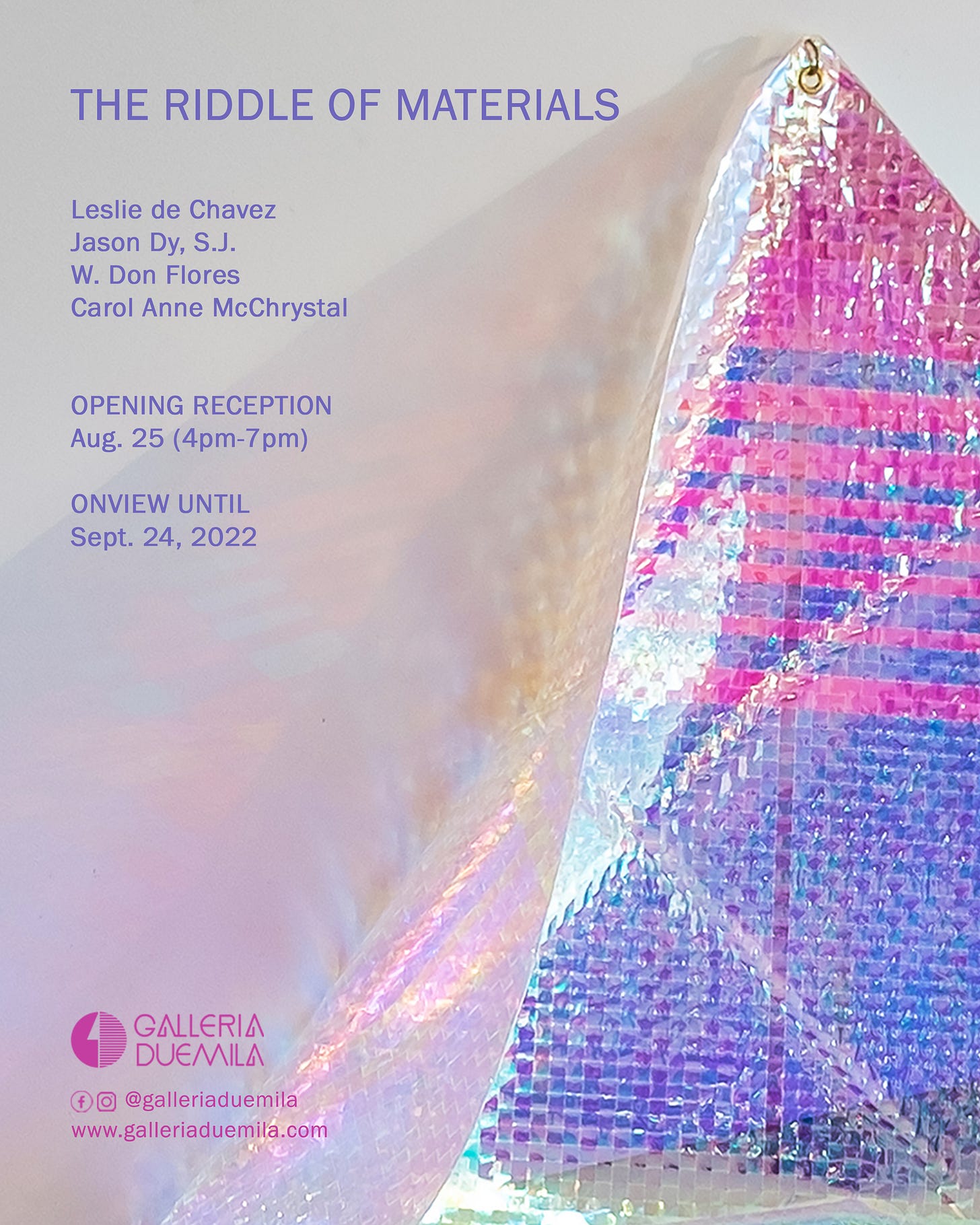The Riddle of Materials
Leslie de Chavez
Jason Dy, SJ
W. Don Flores
Carol Anne McChrystal
25 August-24 September
Materials have their own processes, lives, and stories.
Materials tend not to be bound to linear progression. Though the American painter Joseph Schillinger in his book The Mathematical Basis of the Arts (1943), categorized aesthetic phenomena into phases of mimicry, ritualistic, emotional, rational, and scientific stages, materials have, nonetheless, followed unruly patterns and varied permutations. Materials persisted even as artists foregrounded ideas over form as an attempt to decenter objects and declassify them as commodities. American critic Lucy Lippard, in her essay The Dematerialization of Art (1968, co-authored with John Chandler), argued for art’s trajectory towards pure intellectualism. Even the last posited phase is the “post-aesthetic” where ideas are liberated from their materiality and the engagement with materials has no finality. Materials evolve as artists innovate.
Having worked with various materials, privileged ideas over objects, and engaged with texts on the dissolution of the tangible aspects of art, artists Leslie de Chavez, Jason Dy, SJ, W. Don Flores, and Carol Anne McChrystal, in their group exhibition THE RIDDLE OF MATERIALS, search for critical dialogue through their affinity with their materials. The works of these four artists revisit the ideas of the American artist Allan Kaprow who pioneered creating “environments” and “happenings.” In his essay, The Legacy of Jackson Pollock (1958), Kaprow observed Pollock’s preoccupation with unexpected spaces and the ordinary objects of everyday life in order to have a wider, deeper sense of unheard-of happenings.
De Chavez investigates the symbolic aspects of materials such as lead, beeswax, and dried animal intestines. Through the embedded historicity of these, he finds parallel narratives in the socio-political and cultural contexts of the Philippines.
For his found objects, Dy, SJ takes a cue from Filipino-American abstract expressionist Alfonso Ossorio. For Ossorio, these objects are “sought-for” artifacts that artists reach toward, consciously or unconsciously, for use in their respective inquiries. Misprint textbooks produced by the Philippine Department of Education used as wrappers at the Dangwa Floral Market are imprinted with acrylic leaf prints or graphite rubbings. Various objects like dried flowers, carved santos, synthetic figures, bronze nails, and so on are suspended as mobiles to represent Christian narratives of prophecy and fulfillment.
To be sensitive to the processes of the materials as suggested by anthropologist Tim Ingold in his essay The Materials Of Life (2016), Filipino-American artist McChrystal employs synthetic materials as by-products of oil production such as blue tarpaulin sheets, single-use beverage bottles, and discarded plastic wrappers. These materials are handwoven into geometric patterns and constructed as architectural assemblages to expose the impact of extractive industries and climate catastrophe on local experiences of home and shelter.
Flores uses traditional materials such as acrylic and canvas in contradistinction with the found materials of Dy and McChrystal. His interest lies not in the plasticity of the paint but rather its semiotic connection to the colors of sugarcane fields on fire—where white smoke indicates a low-moisture fire; and black, a high-moisture fire producing more soot. These paintings are of distant signals and urgent warnings arising from the conflicted situation between farmers and landowners in the hacienda setting.
Looking at the works of these artists and how they engage with materials in symbolic parallels, across intuitive levels, along environmental scale, or the semiotic plane, reveals their making, as Ingold would describe it, as “a process of correspondence.” In their works, we recognize a giving of due to raw material substance and the processes of becoming; opening up potential for image-making and making-meaning—an alchemical proposal that materials that cannot be treated as immaterial, linear, or static. (AM+DG 2022).
in case you missed…




